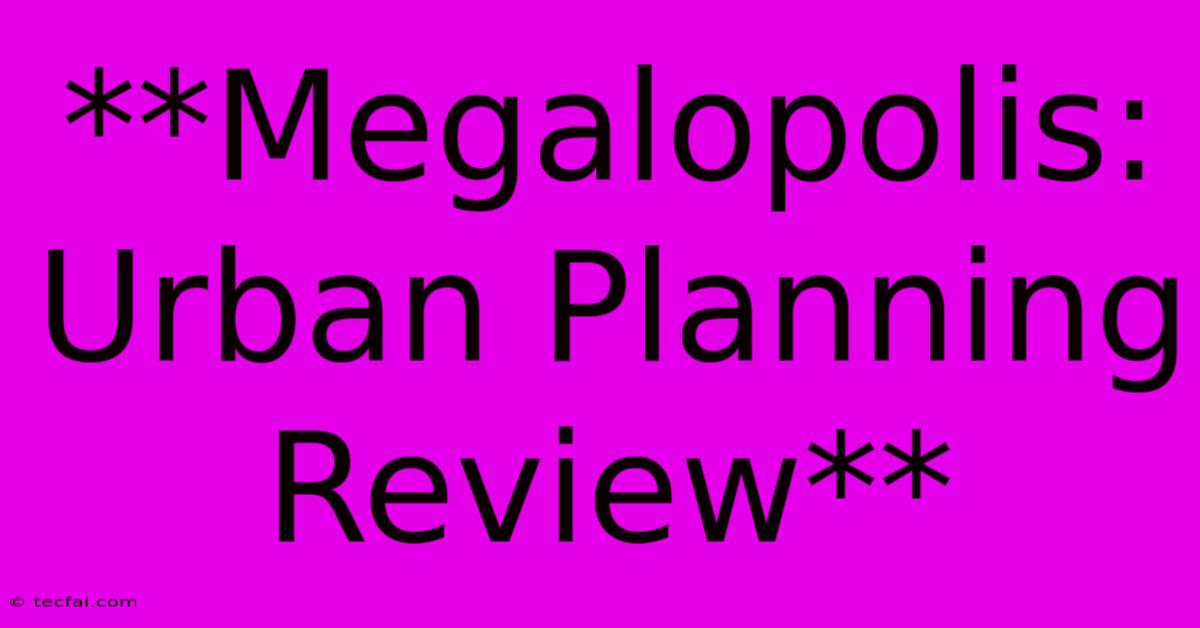**Megalopolis: Urban Planning Review**

Discover more detailed and exciting information on our website. Click the link below to start your adventure: Visit Best Website tecfai.com. Don't miss out!
Table of Contents
Megalopolis: Urban Planning Review
The sprawling urban landscapes we call megalopolises present unique challenges and opportunities for urban planners. These vast, interconnected regions, encompassing multiple cities and suburbs, demand innovative solutions to ensure sustainable growth, efficient infrastructure, and a high quality of life for their millions of inhabitants. This article reviews the current state of megalopolis planning, highlighting key issues and exploring potential avenues for improvement.
The Defining Characteristics of a Megalopolis
Before delving into the specifics of urban planning, it's crucial to understand what defines a megalopolis. It's more than just a large city; it's a continuous urban area formed by the coalescence of several metropolitan areas. Think of the BosWash corridor (Boston-Washington) in the US, the Tokaido Megalopolis in Japan, or the Rhine-Ruhr region in Germany. These regions share characteristics like:
- High population density: Millions of people concentrated within a relatively small geographic area.
- Interconnected infrastructure: Extensive networks of transportation (roads, railways, airports), communication, and utilities.
- Economic interdependence: Closely linked economic activities across multiple cities, leading to complex supply chains and employment patterns.
- Environmental challenges: Increased pollution, resource depletion, and vulnerability to natural disasters.
- Social complexities: Diverse populations, socioeconomic disparities, and the need for inclusive urban planning.
Key Challenges in Megalopolis Planning
Planning for such complex regions presents significant hurdles:
- Sustainable Transportation: Managing traffic congestion, promoting public transportation, and integrating various modes of transport are paramount. Lack of efficient and affordable public transit often leads to increased car dependency and associated environmental problems.
- Housing Affordability: The high cost of living in megalopolises often results in unaffordable housing for many residents. Finding solutions to this issue requires innovative approaches to housing development and policy.
- Infrastructure Development and Maintenance: Maintaining and upgrading aging infrastructure while accommodating future growth is an ongoing challenge, requiring substantial investment and strategic planning.
- Environmental Sustainability: Reducing carbon emissions, improving air and water quality, and mitigating the effects of climate change are crucial considerations. This involves promoting green building practices and implementing effective waste management systems.
- Social Equity and Inclusion: Ensuring equitable access to resources and opportunities for all residents, regardless of income or background, is essential for creating a just and thriving megalopolis. This calls for inclusive urban planning processes that prioritize the needs of vulnerable populations.
Innovative Approaches to Megalopolis Planning
Despite the challenges, numerous innovative approaches are being explored:
- Smart City Technologies: The integration of technology to optimize resource management, improve transportation, and enhance citizen engagement.
- Transit-Oriented Development (TOD): Building dense, mixed-use communities around public transportation hubs to reduce car dependency.
- Green Infrastructure: Integrating green spaces, parks, and natural elements into urban design to improve environmental quality and enhance livability.
- Participatory Planning: Engaging residents in the planning process to ensure their needs and perspectives are considered.
- Regional Governance and Collaboration: Effective cooperation between different municipalities and governmental bodies is critical for coordinated planning and resource allocation.
The Future of Megalopolis Planning
The future of megalopolis planning hinges on the adoption of sustainable, equitable, and resilient strategies. This necessitates a shift from traditional, fragmented approaches to a more holistic and integrated perspective. Collaboration across various sectors, investment in innovative technologies, and a commitment to participatory planning are crucial for creating thriving megalopolises that offer a high quality of life for all their inhabitants. Further research into resilient infrastructure, climate change adaptation, and data-driven urban management will be vital in navigating the challenges and opportunities that lie ahead. The successful planning of megalopolises will be a defining factor in shaping the future of urban living globally.

Thank you for visiting our website wich cover about **Megalopolis: Urban Planning Review**. We hope the information provided has been useful to you. Feel free to contact us if you have any questions or need further assistance. See you next time and dont miss to bookmark.
Featured Posts
-
Actor Timothy West Dead At 90
Nov 14, 2024
-
Trumps Pledge Under Legal Scrutiny
Nov 14, 2024
-
Sinabi Ni De Lima Propaganda Ang Droga
Nov 14, 2024
-
Australia Vs Saudi Arabia World Cup 2026 Preview
Nov 14, 2024
-
Maine Sky Thursday Night Viewing Guide
Nov 14, 2024
